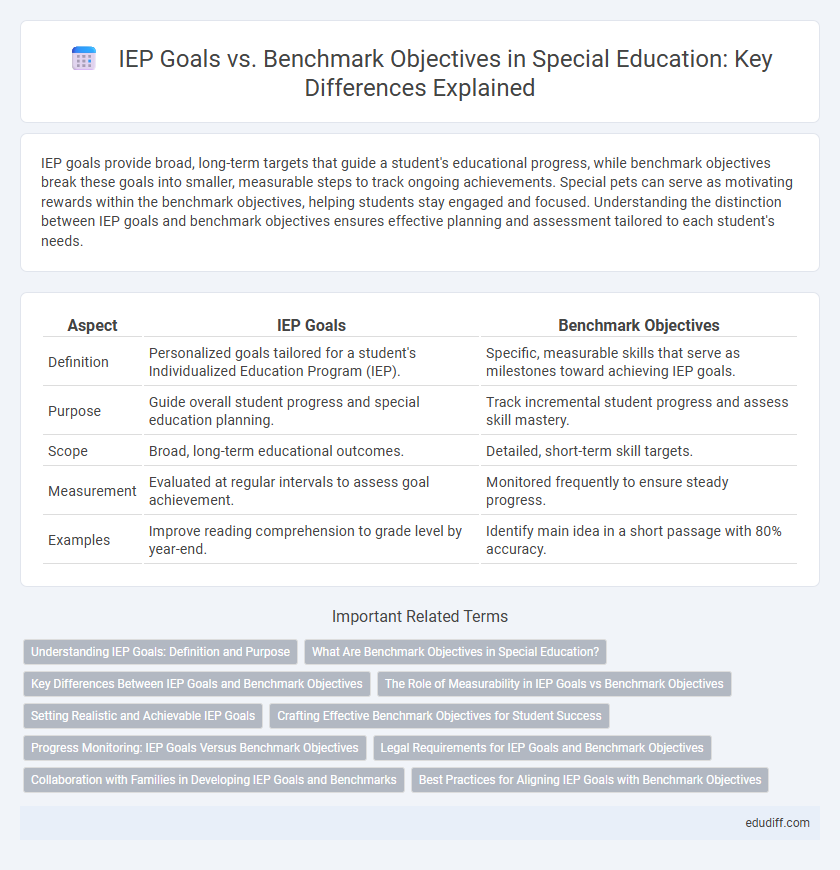IEP goals provide broad, long-term targets that guide a student's educational progress, while benchmark objectives break these goals into smaller, measurable steps to track ongoing achievements. Special pets can serve as motivating rewards within the benchmark objectives, helping students stay engaged and focused. Understanding the distinction between IEP goals and benchmark objectives ensures effective planning and assessment tailored to each student's needs.
Table of Comparison
| Aspect | IEP Goals | Benchmark Objectives |
|---|---|---|
| Definition | Personalized goals tailored for a student's Individualized Education Program (IEP). | Specific, measurable skills that serve as milestones toward achieving IEP goals. |
| Purpose | Guide overall student progress and special education planning. | Track incremental student progress and assess skill mastery. |
| Scope | Broad, long-term educational outcomes. | Detailed, short-term skill targets. |
| Measurement | Evaluated at regular intervals to assess goal achievement. | Monitored frequently to ensure steady progress. |
| Examples | Improve reading comprehension to grade level by year-end. | Identify main idea in a short passage with 80% accuracy. |
Understanding IEP Goals: Definition and Purpose
IEP goals are specific, measurable outcomes designed to address the unique learning needs of students with disabilities, guiding their academic progress over the IEP period. They establish broad targets for skill development that help educators and parents monitor overall growth. Benchmark objectives break these goals into smaller, manageable steps to track periodic progress and ensure goal attainment.
What Are Benchmark Objectives in Special Education?
Benchmark objectives in special education are specific, measurable steps that track a student's progress toward achieving broader Individualized Education Program (IEP) goals. These objectives break down complex skills into smaller, manageable tasks, allowing educators to monitor and adjust instruction effectively. Clear benchmark objectives ensure personalized support tailored to the individual needs of students with disabilities.
Key Differences Between IEP Goals and Benchmark Objectives
IEP goals are broad, long-term targets that outline a student's overall learning and developmental expectations during the school year, while benchmark objectives are specific, measurable steps used to track progress toward these goals. IEP goals focus on skill acquisition in critical areas such as communication, social skills, and academic performance, whereas benchmark objectives break down these goals into smaller, achievable tasks to monitor growth continuously. Precise differentiation between these components ensures tailored instruction and effective progress measurement for students with special needs.
The Role of Measurability in IEP Goals vs Benchmark Objectives
Measurability is crucial in distinguishing IEP goals from benchmark objectives, as IEP goals define broad, long-term achievements while benchmark objectives break these goals into specific, quantifiable steps. IEP goals must be measurable to evaluate overall student progress, whereas benchmark objectives provide detailed criteria for short-term milestones. Effective measurability ensures accurate tracking, data-driven instruction, and targeted interventions tailored to individual student needs.
Setting Realistic and Achievable IEP Goals
Setting realistic and achievable IEP goals requires a clear understanding of the distinction between IEP goals and benchmark objectives, where IEP goals define broad, measurable outcomes for a student's overall progress. Benchmark objectives break those goals into smaller, specific skills that provide a roadmap for incremental learning and ongoing assessment. Aligning these elements ensures that the educational plan remains both practical and tailored to the student's unique strengths and needs.
Crafting Effective Benchmark Objectives for Student Success
Crafting effective benchmark objectives involves breaking down broader IEP goals into specific, measurable, and time-bound targets that track student progress accurately. Benchmark objectives should align closely with the overall IEP goals, providing clear milestones that guide instruction and inform data-driven adjustments. This precision ensures targeted support, fosters student motivation, and enhances the likelihood of achieving meaningful educational outcomes.
Progress Monitoring: IEP Goals Versus Benchmark Objectives
Progress monitoring in special education differentiates between IEP goals and benchmark objectives by measuring overall student growth against specific, measurable short-term skills. IEP goals outline broad educational targets tailored to individual needs, while benchmark objectives break these goals into smaller, assessable steps for tracking incremental progress. Regular data collection on benchmark objectives provides actionable insights, enabling precise adjustments to teaching strategies and support services.
Legal Requirements for IEP Goals and Benchmark Objectives
IEP goals must comply with the Individuals with Disabilities Education Act (IDEA), ensuring they are measurable, individualized, and designed to meet the student's unique needs. Benchmark objectives serve as intermediate steps aligned with these goals, helping monitor progress throughout the academic year while also adhering to state-specific regulations. Both IEP goals and benchmark objectives require documentation and periodic review to meet legal timelines and accountability standards.
Collaboration with Families in Developing IEP Goals and Benchmarks
Collaboration with families in developing IEP goals and benchmark objectives enhances personalized education by incorporating parents' insights and priorities. Effective communication ensures goals are realistic, measurable, and aligned with students' unique needs, fostering shared accountability. Engaging families in this process promotes consistency between home and school interventions, improving student outcomes.
Best Practices for Aligning IEP Goals with Benchmark Objectives
Aligning IEP goals with benchmark objectives enhances individualized education plans by ensuring measurable progress markers directly support overarching educational targets. Best practices emphasize clear, specific, and attainable benchmarks that break down complex IEP goals into manageable, observable steps tailored to the student's unique learning needs. Consistent collaboration among educators, specialists, and families promotes alignment, fostering data-driven adjustments and maximizing student achievement in special education settings.
IEP Goals vs Benchmark Objectives Infographic

 edudiff.com
edudiff.com